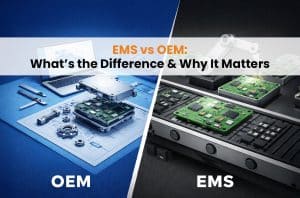The two methods for assembling a PCB are Through-Hole Technology and Surface Mount Technology. Each method has its own strengths and weaknesses and is more suited for certain applications than others. The differences between the two methods will guide one in executing a PCB assembly project.
What is Through-Hole Technology (THT)?
Through-hole technology is simply known as THT. With the THT method, the components pass through the drilled holes made on the PCB. In the later stage, it gets soldered on the other side. Owing to its stable connections being quite durable, it will assure those applications where powerful mechanical bonds are needed. Its long usage history means it is widely used in either prototyping or high-power applications.
Advantages of Through-Hole Technology
- Durability: THT components are mechanically attached very firmly and do not allow much mechanical stress, so it is suitable for high vibration or temperature environments.
- Suitable for Prototyping: THT is used in a prototype as the components can be changed or replaced easily during the test phase.
- High Power Capacity: THT components can handle more current, making them suitable for high-power devices where greater energy is needed.
Limitations of Through-Hole Technology
- Larger PCB Space Required: The need for drilled holes increases PCB size and limits component placement flexibility, making THT less suited for compact designs.
- Higher Costs and Time-Consuming: Drilling and manual soldering make THT assembly more labor intensive and costly.
- Limited Component Density: The larger components mean lower component density, reducing design flexibility.
THT is hence utilized if the development stage requires switching of parts and has a requirement for high power capacity with reliability.
What is Surface Mount Technology (SMT)?
Surface Mount Technology employs components attached directly to the PCB surface without making holes and has SMT components fastened by the solder paste as well as by the reflow process, with the output becoming more efficient with reduced space as compared to contact. Such a technique is highly excellent for PCBs with very high densities that are also compact and majorly applied in consumer electronics as well as other applications existing currently which rely on miniaturization.
Advantages of Surface Mount Technology
- Higher Component Density: In SMT, components are accommodated close to each other; therefore, it can accommodate highly miniaturized designs for more complex and small-sized circuit designs.
- Surface Mount Technology as an automated assembly process has increased speed and lowered the labor intensity and labor costs of human labor through a manual process of assembly.
- Compact and light design: It is highly ideal for lightweight electronics, thereby the high adoption in electronic devices like mobile phones, watches, and other smartwatches.
Limitations of Surface Mount Technology
- Lower Mechanical Strength: SMT connections have a higher susceptibility to damage due to mechanical stress and, hence, lower applicability in stressed environments.
- Lower Power Handling: The current carrying capacity of smaller parts is lower, which means SMT is less suitable for high-power applications.
- Specialized Equipment Required: SMT assembly requires advanced machinery, increasing the initial setup cost for manufacturers.
SMT is, therefore, ideal for small, complex, and mass-produced electronics, particularly where compact size and low weight are priorities.
Key Differences Between THT and SMT
| Feature | Through-Hole Technology (THT) | Surface Mount Technology (SMT) |
| Durability | High, suitable for high-stress environments | Moderate, prone to mechanical damage |
| Component Density | Lower, requires more PCB space | Higher, allows for compact designs |
| Power Capacity | Higher, supports high-power applications | Lower, suited for low-power devices |
| Assembly Process | Mostly manual or semi-automated | Highly automated |
| Cost & Speed | Higher due to drilling and manual labor | Lower, faster due to automation |
Choosing the Best Technology for PCB Assembly
When deciding on a mounting technology, consider these key factors:
- Application Requirements: For high-vibration or high-stress environments, such as automotive or industrial machinery, THT provides a more secure connection. However, for compact consumer electronics, SMT’s compact and efficient design is preferred.
- Budget and Volume: SMT is generally more cost-effective for high-volume production due to its automation, while THT’s manual process can become costly over time.
- Power Needs: If a device requires high power, THT components are often the better choice due to their ability to handle higher currents.
- Design Complexity: SMT allows for higher component density, making it suitable for sophisticated designs that require more components in a compact space.
Which Technology Works Best?
For companies seeking reliable PCB assembly services in India, THT is a strong choice for high-power and high-stress applications. However, for businesses looking for SMT manufacturing services in India, SMT is ideal for efficient, high-volume production in consumer electronics. Working with trusted PCB assembly services in India that offer both methods can help you achieve a balanced approach that meets all design and functional requirements.
Conclusion
Both THT and SMT serve distinct roles in PCB assembly. THT may be the best choice where more strength and high powers are in demand, as against that, SMT will best suit where dense, high-density designs become requirements. It really varies from which one to which the supplier of reliable PCB assembly services in India becomes in terms of providing a contract and that of SMT manufacturing services in India if needed in order to establish a winning project, whether due to THT’s strength or that of SMT and their efficacy for PCB production requirements.


